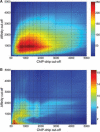PASTAA: identifying transcription factors associated with sets of co-regulated genes
- PMID: 19073590
- PMCID: PMC2642637
- DOI: 10.1093/bioinformatics/btn627
PASTAA: identifying transcription factors associated with sets of co-regulated genes
Abstract
Motivation: A major challenge in regulatory genomics is the identification of associations between functional categories of genes (e.g. tissues, metabolic pathways) and their regulating transcription factors (TFs). While, for a limited number of categories, the regulating TFs are already known, still for many functional categories the responsible factors remain to be elucidated.
Results: We put forward a novel method (PASTAA) for detecting transcriptions factors associated with functional categories, which utilizes the prediction of binding affinities of a TF to promoters. This binding strength information is compared to the likelihood of membership of the corresponding genes in the functional category under study. Coherence between the two ranked datasets is seen as an indicator of association between a TF and the category. PASTAA is applied primarily to the determination of TFs driving tissue-specific expression. We show that PASTAA is capable of recovering many TFs acting tissue specifically and, in addition, provides novel associations so far not detected by alternative methods. The application of PASTAA to detect TFs involved in the regulation of tissue-specific gene expression revealed a remarkable number of experimentally supported associations. The validated success for various datasets implies that PASTAA can directly be applied for the detection of TFs associated with newly derived gene sets.
Availability: The PASTAA source code as well as a corresponding web interface is freely available at http://trap.molgen.mpg.de.
Figures



Similar articles
-
Condition-specific target prediction from motifs and expression.Bioinformatics. 2014 Jun 15;30(12):1643-50. doi: 10.1093/bioinformatics/btu066. Epub 2014 Feb 14. Bioinformatics. 2014. PMID: 24532727
-
CORE_TF: a user-friendly interface to identify evolutionary conserved transcription factor binding sites in sets of co-regulated genes.BMC Bioinformatics. 2008 Nov 26;9:495. doi: 10.1186/1471-2105-9-495. BMC Bioinformatics. 2008. PMID: 19036135 Free PMC article.
-
Comparative promoter region analysis powered by CORG.BMC Genomics. 2005 Feb 21;6:24. doi: 10.1186/1471-2164-6-24. BMC Genomics. 2005. PMID: 15723697 Free PMC article.
-
KnockTF: a comprehensive human gene expression profile database with knockdown/knockout of transcription factors.Nucleic Acids Res. 2020 Jan 8;48(D1):D93-D100. doi: 10.1093/nar/gkz881. Nucleic Acids Res. 2020. PMID: 31598675 Free PMC article.
-
Network motif-based identification of transcription factor-target gene relationships by integrating multi-source biological data.BMC Bioinformatics. 2008 Apr 21;9:203. doi: 10.1186/1471-2105-9-203. BMC Bioinformatics. 2008. PMID: 18426580 Free PMC article.
Cited by
-
Comparative motif discovery combined with comparative transcriptomics yields accurate targetome and enhancer predictions.Genome Res. 2013 Jan;23(1):74-88. doi: 10.1101/gr.140426.112. Epub 2012 Oct 15. Genome Res. 2013. PMID: 23070853 Free PMC article.
-
IGAP-integrative genome analysis pipeline reveals new gene regulatory model associated with nonspecific TF-DNA binding affinity.Comput Struct Biotechnol J. 2020 Jun 2;18:1270-1286. doi: 10.1016/j.csbj.2020.05.024. eCollection 2020. Comput Struct Biotechnol J. 2020. PMID: 32612751 Free PMC article.
-
Genetic Adaptation and Neandertal Admixture Shaped the Immune System of Human Populations.Cell. 2016 Oct 20;167(3):643-656.e17. doi: 10.1016/j.cell.2016.09.024. Cell. 2016. PMID: 27768888 Free PMC article.
-
Characterization of a Novel Compound That Stimulates STING-Mediated Innate Immune Activity in an Allele-Specific Manner.Front Immunol. 2020 Jul 8;11:1430. doi: 10.3389/fimmu.2020.01430. eCollection 2020. Front Immunol. 2020. PMID: 32733475 Free PMC article.
-
Transdifferentiation of human endothelial progenitors into smooth muscle cells.Biomaterials. 2016 Apr;85:180-194. doi: 10.1016/j.biomaterials.2016.01.066. Epub 2016 Feb 3. Biomaterials. 2016. PMID: 26874281 Free PMC article.
References
-
- Aoki KF, Kanehisa M. Unit 1. 12: Using the KEGG database resource, Chapter 1. Curr. Protoc. Bioinformatics. 2005 - PubMed
-
- Bailey TL, Elkan C. The value of prior knowledge in discovering motifs with MEME. Proc. Int. Conf. Intell. Syst. Mol. Biol. 1995;3:21–29. - PubMed
-
- Carninci P, et al. Genome-wide analysis of mammalian promoter architecture and evolution. Nat. Genet. 2006;38:626–635. - PubMed
Publication types
MeSH terms
Substances
LinkOut - more resources
Full Text Sources
Miscellaneous

